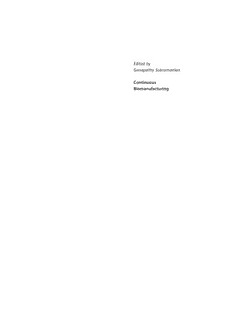
Continuous biomanufacturing : innovative technologies and methods PDF
Preview Continuous biomanufacturing : innovative technologies and methods
Editedby GanapathySubramanian Continuous Biomanufacturing Continuous Biomanufacturing Innovative Technologies and Methods Edited by Ganapathy Subramanian Editor AllbookspublishedbyWiley-VCHarecarefully produced.Nevertheless,authors,editors,and Prof.Dr.GanapathySubramanian publisherdonotwarranttheinformationcontainedin 44OakenGrove thesebooks,includingthisbook,tobefreeoferrors. SL66HHMaidenhead,Berkshire Readersareadvisedtokeepinmindthatstatements, UnitedKingdom data,illustrations,proceduraldetailsorotheritems Cover mayinadvertentlybeinaccurate. Picturesbeingused:Coagulation factorVIIIproteinrendering LibraryofCongressCardNo.: Molekuul.be;Vitaminpillscst21; appliedfor Measurementdevicecontaining BritishLibraryCataloguing-in-PublicationData closedvialseGraphia. Acataloguerecordforthisbookisavailablefrom theBritishLibrary. Bibliographicinformationpublishedby theDeutscheNationalbibliothek TheDeutscheNationalbibliothekliststhis publicationintheDeutscheNationalbibliografie; detailedbibliographicdataareavailableonthe Internetat<http://dnb.d-nb.de/>. 2018Wiley-VCHVerlagGmbH&Co.KGaA, Boschstr.12,69469Weinheim,Germany Allrightsreserved(includingthoseoftranslation intootherlanguages).Nopartofthisbookmaybe reproducedinanyform–byphotoprinting, microfilm,oranyothermeans–nortransmittedor translatedintoamachinelanguagewithoutwritten permissionfromthepublishers.Registerednames, trademarks,etc.usedinthisbook,evenwhennot specificallymarkedassuch,arenottobe consideredunprotectedbylaw. PrintISBN:978-3-527-34063-7 ePDFISBN:978-3-527-69989-6 ePubISBN:978-3-527-69991-9 MobiISBN:978-3-527-69992-6 oBookISBN:978-3-527-69990-2 CoverDesignBlueseaDesign,MacLeeseLake,Canada TypesettingThomsonDigital,Noida,India PrintingandBinding Printedonacid-freepaper 10 9 8 7 6 5 4 3 2 1 v Contents ListofContributors xix PartOne: OverviewofState-of-the-ArtTechnologiesand Challenges 1 1 ContinuousBioprocessDevelopment:MethodsforControland CharacterizationoftheBiologicalSystem 3 PeterNeubauerandM.NicolasCruz-Bournazou 1.1 ProposedAdvantagesofContinuousBioprocessing 3 1.1.1 Introduction 3 1.2 SpecialChallengesforContinuousBioprocesses 5 1.2.1 TheBiologicalSysteminContinuousBiomanufacturing 5 1.2.2 InherentChangesintheMicrobialSystem–ProblemofEvolution 6 1.2.3 LackofProcessInformation 7 1.2.3.1 Models-BasedProcessDevelopmentandControlforContinuous Processes 8 1.2.3.2 EngineeringApproachtoComplexSystems 8 1.2.4 LimitedControlStrategies 9 1.2.4.1 TraditionalControlStrategiesforContinuousCultures 9 1.3 ChangesRequiredtoIntegrateContinuousProcessesin Biotech 11 1.3.1 ABetterPhysiologicalUnderstandingoftheOrganismsandTheir ResponsesontheReactorEnvironment 11 1.3.1.1 ModelComplexity 11 1.3.1.2 Models 12 1.3.2 Model-BasedProcessMonitoring 13 1.3.3 ImplementationofModelPredictiveControl 14 1.3.3.1 Model-BasedControl 14 1.4 RoleofIterativeProcessDevelopmenttoPushContinuousProcesses inBiotech 14 1.4.1 MethodsforDevelopmentofContinuousProcesses 14 1.4.1.1 Alternative:Fed-BatchasaSystemtoSimulateQuasiSteady-State Conditions 16 vi Contents 1.4.2 MimickingIndustrialScaleConditionsintheLab:Continuous-Like Experiments 17 1.4.2.1 ASimpleModelforContinuousProcesses 17 1.4.2.2 Continuous-LikeFed-BatchCultivations 18 1.4.3 FastandParallelExperimentalApproacheswithHighInformation Content 20 1.4.3.1 Computer-AidedOperationofRoboticFacilities 20 1.4.3.2 ModelBuildingandExperimentalValidation 21 1.5 Conclusions 22 References 22 2 ToolsEnablingContinuousandIntegratedUpstreamandDownstream ProcessesintheManufacturingofBiologicals 31 RimenysJ.CarvalhoandLedaR.Castilho 2.1 Introduction 31 2.2 ContinuousUpstreamProcesses 32 2.2.1 ContinuousBioprocesses:WithorWithoutCellRecycle? 33 2.2.2 Early/Scale-DownPerfusionDevelopment 34 2.2.3 FeedingandOperationalStrategiesinPerfusionProcesses 35 2.2.4 CellRetentionDevices 36 2.3 ContinuousDownstreamProcesses 41 2.3.1 ContinuousLiquidChromatography(CLC) 42 2.3.1.1 ContinuousAnnularChromatography(CAC) 42 2.3.1.2 TrueandSimulatedMovingBedChromatography(TMB/SMB) 43 2.3.1.3 MulticolumnCountercurrentSolventGradientPurification (MCSGP) 45 2.3.1.4 PeriodicCountercurrentChromatography(PCC) 47 2.3.1.5 ContinuousCountercurrentTangentialChromatography (CCTC) 50 2.3.2 NonchromatographicContinuousProcesses 51 2.3.2.1 ContinuousAqueousTwo-PhaseSystems 51 2.3.2.2 ContinuousProteinPrecipitation 52 2.3.3 Straight-ThroughProcesses 53 2.3.4 ContinuousVirusClearanceProcesses 54 2.4 IntegratedContinuousProcesses 55 2.5 ConcludingRemarks 59 References 60 3 EngineeringChallengesofContinuousBiomanufacturing Processes(CBP) 69 HolgerThiess,SteffenZobel-Roos,PetraGronemeyer,ReinhardDitz, andJochenStrube 3.1 Introduction 69 3.1.1 ContinuousManufacturing 69 3.1.2 ContinuousManufacturingofSyntheticMolecules 69 3.1.3 ContinuousManufacturingofBiologics 69 3.2 AnalysisofCBPStatus 71 Contents vii 3.3 CaseStudies 74 3.4 StatusandNeedsforResearchandDevelopment 77 3.5 EngineeringChallenges 79 3.5.1 PlatformMethodofQbD-DrivenProcessModelingInsteadofUnit OperationOrientedPlatformApproaches 80 3.5.2 DataDrivenDecisions 81 3.5.3 Analytics 82 3.5.4 QbDMethods 82 3.5.5 UpstreamandDownstreamIntegration 82 3.5.6 BufferHandling/Recycling 83 3.5.7 ProcessIntegrationofInnovativeUnitOperations 84 3.5.8 ABC(AnythingButorBeyondChromatography)andAAC(Anything andChromatography) 84 3.5.8.1 Liquid–LiquidExtractionBasedonATPE 84 3.5.8.2 Precipitation 86 3.5.8.3 MembraneAdsorbers 87 3.5.8.4 InnovativeMaterialsLikeFibersorMatrices 88 3.5.9 ProcessConceptsformAbsandFragments 88 3.5.10 Single-UseTechnology 91 3.5.11 GuidedDecisionforCBP 91 3.6 ConclusionandOutlook 96 Acknowledgments 97 References 97 PartTwo: AutomationandMonitoring(PAT) 107 4 ProgressTowardAutomatedSingle-UseContinuousMonoclonal AntibodyManufacturingviatheProteinRefinery OperationsLab 109 DavidPollard,MarkBrower,andDouglasRichardson 4.1 Introduction 109 4.2 ProteinRefineryOperationsLab 111 4.2.1 Introduction 111 4.2.2 ProteinRefineryOperationsLab:DesignandImplementation 112 4.2.3 ProteinRefineryOperationsLab:ProcessAnalyticalTechnology (PAT)andProductAttributeControl(PAC)fortheTransitionto Real-TimeRelease(RTR) 117 4.2.3.1 ProteinRefineryOperationsLab:CurrentStateofPAT Technologies 118 4.3 ProteinRefineryOperationsLab:CaseStudies 122 4.3.1 CaseStudy:Perfusion 122 4.3.2 CaseStudy:ContinuousPurification 124 4.3.3 CaseStudy:ProofofConceptAutomatedHandlingofDeliberate ProcessDeviations 127 4.3.3.1 PerfusionProcessDeviationAnalysis(Bioreactor TemperatureShift) 127 viii Contents 4.3.3.2 DownstreamProcessDeviationAnalysis (ViralInactivationpH) 128 4.4 Summary 129 Acknowledgments 129 References 129 PartThree: SingleUseTechnologiesandPerfusion Technologies 131 5 Single-UseBioreactorsforContinuousBioprocessing:Challengesand Outlook 133 NicoM.G.Oosterhuis 5.1 Introduction 133 5.2 Single-UseReactorTypes 135 5.3 MaterialAspects 136 5.4 Sensors 139 5.5 ReactorDesign 141 5.5.1 MassTransferandMixingRequirementsforContinuous Processing 141 5.6 Scale-UpAspects 142 5.7 ContinuousSeedTrain 145 5.8 NewMixerDesigns 145 5.9 FutureOutlook 146 References 147 6 TwoMutuallyEnablingTrends:ContinuousBioprocessing andSingle-UseTechnologies 149 MarcBisschops,MarkSchofield,andJulieGrace 6.1 Introduction 149 6.2 Single-UseTechnologies 150 6.2.1 HistoryofSingle-UseTechnologies 150 6.2.2 Single-UseUpstreamProcessing 151 6.2.3 Single-UseDownstreamProcessing 151 6.2.3.1 TangentialFlowFiltration 151 6.2.3.2 ChromatographySteps 152 6.2.4 EarlySkepticism 152 6.2.5 CurrentTrendsandFuturePredictions 153 6.3 ContinuousBioprocessing 154 6.3.1 ContinuousUpstreamProcessing 154 6.3.2 ContinuousDownstreamProcessing 155 6.3.2.1 TangentialFlowFiltration 156 6.3.2.2 ContinuousChromatography 157 6.3.3 ConcernsforContinuousBioprocessing 158 6.4 IntegratedSingle-UseContinuousBioprocessing:CaseStudies 159 6.4.1 Case1:Genzyme 159 6.4.2 Case2:Merck 160 Contents ix 6.4.3 Case3:BayerTechnologyServices 161 6.4.4 Comparison 162 6.4.5 ChallengesandSolutions 163 6.4.6 AlternativeScenarios 164 6.5 RegulatoryAspects 164 6.6 AdoptionRateofSingle-UseandContinuousBioprocessing 165 6.7 Conclusions 166 References 167 7 PerfusionFormatsandTheirSpecificMediumRequirements 171 JochenB.Sieck,ChristianSchild,andJörgvonHagen 7.1 Introduction 171 7.1.1 HistoryofPerfusion 172 7.1.2 ComebackofPerfusion 172 7.2 CharacterizationofPerfusionProcesses 173 7.2.1 ProductivityofPerfusionProcesses 175 7.2.2 CellRetentionDevices 176 7.2.3 Steady-StateDefinition 176 7.3 PerfusionFormats 177 7.3.1 InnovativePerfusionFormats 178 7.4 DevelopmentStrategiesforPerfusionMedia 179 7.4.1 CellLine-SpecificRequirements 181 7.4.2 Scale-DownModelsforPerfusionProcesses 181 7.4.3 Scale-DownCultivationMethods 182 7.4.4 ExamplesforPerfusionScale-DownApplications 184 7.5 ProcessDevelopmentforPerfusionProcesses 185 7.6 CaseStudy 185 7.6.1 Material&Methods 186 7.6.1.1 SemicontinuousChemostat(SCC) 187 7.6.1.2 RepeatedBatch(RB) 187 7.6.1.3 SemicontinuousPerfusion(SCP) 187 7.6.2 Results 187 7.6.2.1 DeterminationoftheStartingCellDensity 187 7.6.3 Scale-DownModelComparison 188 7.6.4 MediaScreening 189 7.6.5 BioreactorConfirmation 191 7.7 Conclusion 192 Abbreviations 193 References 194 PartFour: ContinuousUpstreamBioprocessing 201 8 UpstreamContinuousProcessDevelopment 203 SanjeevK.Gupta 8.1 Introduction 203 8.2 UpstreamProcessesinBiomanufacturing 205 x Contents 8.2.1 UpstreamOperatingModes 206 8.2.1.1 Fed-BatchProcess 206 8.2.1.2 Continuous/PerfusionProcess 207 8.3 TheUpstreamContinuous/PerfusionProcess 207 8.3.1 UpstreamProcess-TypeSelection 209 8.3.2 ComponentofContinuousUpstreamandDownstream Processes 209 8.3.2.1 UpstreamComponents:StainlessSteelandSingle-Use(Su) 209 8.3.2.2 DownstreamComponents:StainlessSteelandSingle-Use(Su) 209 8.3.3 CellRetentionDevicesUsedinPerfusionProcess 210 8.3.3.1 SpinFilters 210 8.3.3.2 TheATFSystem 210 8.3.3.3 BiosepAcousticPerfusionSystem 212 8.3.3.4 TFFCellRetentionDevice 213 8.4 ManufacturingScale-UpChallenges 214 8.4.1 ProcessComplexityandControl 214 8.4.2 CellLineStability 215 8.4.3 Validation 215 8.5 Single-UseTechnologies:AParadigmChange 215 8.5.1 ApplicationofSUBsinContinuousProcessing 218 8.5.2 Single-UseContinuousBioproduction 218 8.5.3 Single-UsePerfusionBioreactors 219 8.5.3.1 TypeofSingle-UseBioreactorsforPerfusionCulture 219 8.5.4 Single-UseAccessoriesSupportingPerfusionCulture 220 8.5.4.1 HollowFiberMediaExchange 220 8.5.4.2 ContinuousFlowCentrifugation 220 8.5.4.3 AcousticWaveSeparation 220 8.5.4.4 Spinfilters 220 8.6 FDASupportsContinuousProcessing 221 8.7 MakingtheSwitchfromBatch/Fed-BatchtoContinuous Processing 222 8.8 CostsandBenefitsofContinuousManufacturing 222 8.9 CostsofAdoption 223 8.10 ContinuousDownstreamProcessing 223 8.11 IntegratedContinuousManufacturing 224 8.12 ConcludingRemark 227 Acknowledgment 228 References 228 9 StudyofCellsintheSteady-StateGrowthSpace 233 StenErm,KristoAbner,AndrusSeiman,KaarelAdamberg,andRaivoVilu 9.1 Introduction 233 9.1.1 OnPhysiologicalStateofCells:Steady-StateGrowthSpace Analysis 234 9.1.2 ChallengeofComprehensiveQuantitativeSteady-StateGrowthSpace Analysis(SSGSA) 236 9.1.3 ChemostatCulture–AClassicalToolforSSGSA 236
